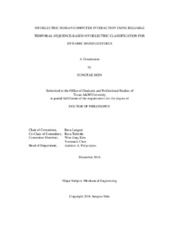| dc.description.abstract | To put a computerized device under human control, various interface techniques have been commonly studied in the realm of Human Computer Interaction (HCI) design. What this dissertation focuses on is a myoelectric interface, which controls a device via neuromuscular electrical signals. Myoelectric interface has advanced by recognizing repeated patterns of the signal (pattern recognition-based myoelectric classification). However, when the myoelectric classification is used to extract multiple discrete states within limited muscle sites, there are robustness issues due to external conditions: limb position changes, electrode shifts, and skin condition changes. Examined in this dissertation is the robustness issue, or drop in the performance of the myoelectric classification when the limb position varies from the position where the system was trained.
Two research goals outlined in this dissertation are to increase reliability of myoelectric system and to build a myoelectric HCI to manipulate a 6-DOF robot arm with a 1-DOF gripper. To tackle the robustness issue, the proposed method uses dynamic motions which change their poses and configuration over time. The method assumes that using dynamic motions is more reliable, vis-a-vis the robustness issues, than using static motions. The robustness of the method is evaluated by choosing the training sets and validation sets at different limb positions. Next, an HCI system manipulating a 6-DOF robot arm with a 1-DOF gripper is introduced. The HCI system includes an inertia measurement unit to measure the limb orientation, as well as EMG sensors to acquire muscle force and to classify dynamic motions. Muscle force and the orientation of a forearm are used to generate velocity commands. Classified dynamic motions are used to change the manipulation modes. The performance of the myoelectric interface is measured in terms of real-time classification accuracy, path efficiency, and time-related measures.
In conclusion, this dissertation proposes a reliable myoelectric classification and develops a myoelectric interface using the proposed classification method for an HCI application. The robustness of the proposed myoelectric classification is verified as compared to previous myoelectric classification approaches. The usability of the developed myoelectric interface is compared to a well-known interface. | en |


